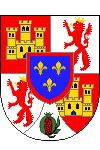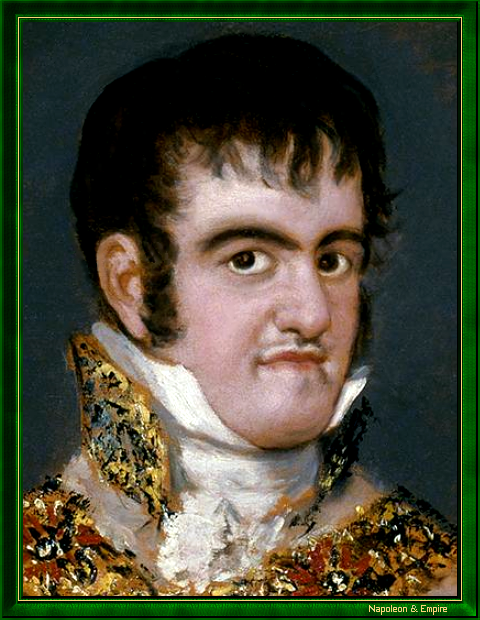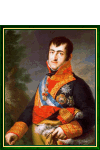King of Spain in 1808, later from 1814 to 1833
Pronunciation:

Born in Madrid on October 14, 1784, he was the son of Spanish King Charles IV and Maria Luisa of Parma.
His opposition to his father's favorite and his mother's lover, Prime Minister Manuel Godoy, Prince of Peace, led to Ferdinand's arrest in October 1807. A popular uprising ensued against the favorite, nearly costing him his life. His palace in Aranjuez, where the royal family had taken refuge pending a possible departure for the Americas, was invaded by the people on March 17, 1808. Led by supporters of the Prince of Asturias (a title traditionally held by the son of the King of Spain), the rioters succeeded in abdicating Charles IV and proclaiming the Crown Prince King.
His reign was brief, from March 19 to May 5 1808. Napoleon I took advantage of these events to intervene in the conflict. He imposed his arbitration, summoned the Spanish royal family to Bayonne and forced both father and son to relinquish their crowns to him. He soon disposed of it in favor of his own brother Joseph Bonaparte.
Ferdinand was sent to the Château de Valençay, owned by Charles-Maurice de Talleyrand-Périgord, three hundred kilometers from Paris. There, until 1813, the exile led a pleasant life, showing the flattest adulation for the Emperor who held him prisoner. At the end of that year, Napoleon, faced with growing difficulties, agreed, under the Treaty of Valençay (December 11, 1813), to once again recognize Ferdinand VII as King of Spain. In exchange, he made peace with France, declared himself neutral for the rest of the war, undertook to expel the British from his states, and pardoned Joseph's supporters, the Afrancesados.
On March 14, 1814, the restored sovereign returned to his country. On the following May 14, supported by a deliriously enthusiastic population, he re-established the absolute monarchy and the Inquisition by decree, refusing to recognize the Constitution adopted by the Cortes. His subsequent policies did not belie these initial steps. As cruel as he was debauched, Ferdinand persecuted liberals and the press, banned Masonic societies, exiled Afrancesados despite his promises, and closed universities.
In 1820, a military uprising forced him to swear an oath to the Constitution. Ferdinand, apparently submissive, nonetheless conspired to re-establish the absolute monarchy, which France allowed him to do by intervening in 1823, at the instigation of François-René de Chateaubriand.
The last ten years of the reign were so catastrophic that they earned the nickname of the Abominable Decade. The ferocious repression of opponents was compounded by the loss of the American colonies and an inability to settle the royal succession, leading to a crisis that gave rise to the First Carlist War (1833-1846).
Ferdinand died in his home town on September 29, 1833.
"King Ferdinand VII of Spain" by Francisco José de Goya y Lucientes (Fuendetodos 1746 - Bordeaux 1828).

Ferdinand VII married in 1802 his first cousin Princess Maria Antonietta of the Two Sicilies, in 1816 his niece Maria Isabel de Bragança, Princess of Portugal, in 1819 Princess Maria Josepha of Saxony, lastly in 1829 his niece Maria Christina of Bourbon-Two Sicilies.
Los Correos de España (Spanish postal service) issued in 1978 a fifteen Pesetas stamp bearing the effigy King Ferdinand VII.
Other portraits

Enlarge
"Ferdinand VII of Spain" by Vicente López y Portaña (Valencia 1772 - Madrid 1850).